Update on Iran’s Nuclear Program
A week after intense negotiations in Geneva between the United States, its international partners, and Iran failed to arrive at an interim deal, the International Atomic Energy Agency (IAEA) released the findings of its latest inspections of Iran’s nuclear facilities. The report shows that most measures of Iran’s nuclear program and most of its nuclear activities remain largely unchanged. Iran continues to produce 3.5 percent and 20 percent enriched uranium at roughly the same pace using roughly the same number of centrifuges as for the past year; and its stockpile of 20 percent enriched uranium has remained stable, as it continues to convert most of what it produces into reactor fuel, as it has been for the year and a half.
There is one notable exception to this trend of continuity. After a year of rapidly expanding its Natanz enrichment plant with current- and next-generation centrifuges, Iran installed almost no new machines during the last reporting period. This is a welcome development. While it does not slow – let alone roll back – Iran’s nuclear program; it does slow the advancement of its potential capabilities. This lack of new installations also raises more questions than it answers.
For more than a year, there has been a growing gulf between Iran’s actual and latent nuclear capability. In February 2012, Iran was using almost all of its installed centrifuges to produce enriched uranium. At Natanz, it had 9,156 centrifuges installed and was using 8,808 of them to enrich uranium to 3.5 percent. Similarly, the Fordow facility was using all of the 696 centrifuges installed at the time to produce 20 percent enriched uranium. Since then, however, Iran has been adding centrifuges to both facilities, without significantly increasing the number in operation. Today, Iran is still using about 8,840 and 696 centrifuges at Natanz and Fordow, respectively. But it has a total of almost 16,500 installed at the former, including 1,008 advanced IR-2m centrifuges, believed to be capable of enriching uranium faster than the current IR-1 model, and more than 2,700 at the latter.
Currently, Iran is producing about 155 kilograms of 3.5 percent and 10.4 kilograms of 20 percent enriched uranium per month. If it were to switch on all of its centrifuges, it could be producing 321 kilograms of 3.5 percent and 32 kilograms of 20 percent enriched uranium per month. These latter figures are its latent capability. In short, Iran could more than double the output of its nuclear program just by turning on the centrifuges it already has installed.
This would also have an impact on its ability to graduate to a nuclear weapons capability. Right now, conservative estimates suggest Iran would require roughly three months to produce 20 kilograms of weapons grade uranium using just its current operating centrifuges. But with its latent capability, that window falls by half, to about six weeks.
The continued expansion of Iran’s latent capability, therefore, poses perhaps the largest breakout threat of any of its nuclear activities. That it has stopped, for now at least, means that Iran’s potential ability to breakout has also not progressed much further in the three months since the last IAEA report in August 2013. But a slowdown in the acceleration of its nuclear program should not be confused with a slowing of the program overall. Iran is not getting any further from a nuclear weapon, and that is the main metric that should preoccupy policymakers.
Nevertheless, the cessation of centrifuge installation at Natanz is meaningful. But the mere fact that Iran has not put in any more centrifuges is not enough to tell us what to think of this development. Several potential interpretations present themselves:
- Building goodwill: Iran’s new president, Hassan Rouhani, has chosen to stop the installation of centrifuges of Natanz to signal to the international community his willingness to compromise and reach a deal.
- Negotiations tactic: The move might not be sincere. Instead, occurring during a period of renewed negotiations, it might be a tactic to convince the United States to grant concessions, without Iran having to actually relinquish any of its existing nuclear capability.
- Technical difficulties: With extremely limited ability to import the materials needed to build centrifuges, due to sanctions, Iran might have run out of supplies or otherwise encountered other technical difficulties that have prevented it from building any more centrifuges.
- Change of focus: Having expanded the Natanz enrichment plant, Iran might have changed focus from further growing its latent capability to increasing its actual output. There is precedent for this as, in the past, there have been periods where Iran either first installed additional centrifuges and then, over time, brought them on line, or focused on making the operating centrifuges more productive. Iran could be preparing to pursue one of these two paths again.
Because it is unclear why Iran has stopped installing additional centrifuges, the United States should continue applying pressure according to the triple-track strategy of diplomacy, sanctions and credible and visible preparations of the military option, laid out by the Bipartisan Policy Center’s (BPC) Iran Task Force, co-chaired by Senator Charles Robb and General (ret.) Charles Wald. Moreover, if diplomacy is to succeed, the growing disagreement between the White House and Capitol Hill about how to negotiate and what to demand from Iran needs to be addressed. BPC has released a proposed framework for such improved executive-legislative cooperation.
Additional details and highlights from the IAEA report include:
Enrichment Rate and Output Remains at All-Time High
-
Production of 3.5 percent enriched uranium remains at all time high level, triple pre-Stuxnet rate.2
- Between August and November 2013, Iran produced average of 155 kg/month.
- Effectively same rate for the last year;
- Fastest previous rate (Feb. 2012): 115 kg/month;
- 2010 average: 83 kg/month;
- 2009 average: 56 kg/month.
- Known 3.5 percent enriched uranium stockpile reaches 4,579 kg. At current enrichment level can fuel nuclear reactor; enough, when enriched to 90 percent, for at least two nuclear weapons.
- Between August and November 2013, Iran produced average of 155 kg/month.
-
Production rate of 20 percent enriched uranium continues apace.
- Combined (Fordow + Natanz) 20 percent enriched production rate: 10.1 kg/month;
- 2012 average: 8.8 kg/month
- 2011 average: 2.6 kg/month
- Combined (Fordow + Natanz) 20 percent enriched production rate: 10.1 kg/month;
Iran Draws Down 20 Percent Enriched Uranium Stockpile
-
Iran removes 20 kg of 20 percent enriched uranium for processing into reactor fuel.
- Sixth time Iran has done this, for total of 145 kg removed:
- May 2012: 30 kg removed;
- Nov. 2012: 36 kg removed;
- Feb. 2013: 10.2 kg removed;
- May 2013: 18.8 kg removed;
- August 2013: 30 kg removed.
- Nov. 2013: 20 kg removed
- Iran has produced 277.4 kg of 20 percent enriched uranium.
- But only 133.1 kg remain in its stockpile.
- 155 kg of 20 percent enriched uranium is minimum needed, with further enrichment, for a nuclear weapon and is also believed to constitute Israel’s red line.
- Sixth time Iran has done this, for total of 145 kg removed:
Enrichment Facilities
-
No major expansion of Natanz.
- Number of operating centrifuges falls slightly from 9,156 to 8,840;
- 15,420 IR-1 centrifuges installed total;
- Only 4 more than in August 2013.
-
No additional next-generation centrifuges installed.
- 1,008 IR-2m centrifuges have been fully installed;
- Same number as in August 2013.
-
Fordow facility almost completed.
- Number of operating centrifuges steady at 696;
- Installed centrifuges remains at just over 2,700, close to maximum capacity of facility.
Latent Capability
-
Production of 3.5 percent enriched uranium could more than double if all centrifuges at Natanz used.
- There are more than 7,500 unused centrifuges at Natanz:
- 6,580 installed, but unoperational IR-1 centrifuges;
- 1,008 installed, but unoperational IR-2m centrifuges.
- If switched on, these centrifuges could produce an additional 167 kg of 3.5 percent enriched uranium per month.
- Combined with the current production (154 kg/month) that would yield 321 kilograms of 3.5 percent enriched uranium per month:
- This would be more than double current rate;
- Would allow Iran to produce at least one weapon’s worth of 3.5 percent enriched uranium a year.
- There are more than 7,500 unused centrifuges at Natanz:
-
Production of 20 percent enriched uranium could triple when Fordow is made fully-operational.
- Currently, 696 centrifuges at Fordow produce 7.0 kg of 20 percent enriched per month;
- Once operational, remaining 2,014 centrifuges could produce additional 21 kg of 20 percent enriched per month;
- Total 20 percent enriched production (fully-operational Fordow + Natanz) could reach: 31 kg/month.
Iran Simultaneously Cooperates with and Defies IAEA
-
Iran agreed to a Framework of Cooperation with IAEA.
- Under this framework, Iran agrees to provide the IAEA with additional information about some of its nuclear activities, specifically:
- Gchine uranium mine;
- Heavy Water Production Plant;
- New research reactors;
- Sites for new nuclear power plants;
- New enrichment facilities;
- Plans for laser enrichment.
- These are mostly activities that Iran is planning, but has not yet undertaken.
- Thus, this cooperation does little to grant IAEA greater access to Iran’s ongoing nuclear program.
- Under this framework, Iran agrees to provide the IAEA with additional information about some of its nuclear activities, specifically:
-
Iran continues to defy IAEA and United Nations Security Council resolutions in other areas.
- Iran has not yet answered IAEA concerns about the “possible existence in Iran of undisclosed nuclear related activities involving military organizations, including activities related to the development of a nuclear payload for a missile.”
- Iran has not yet granted IAEA access to the Parchin military complex where testing of explosives designed for a nuclear device is believed to have taken place. Moreover, that facility has been razed.
- Iran has not yet signed on to the IAEA’s Additional Protocol, allowing it to conduct broader inspections, despite resolutions by both the IAEA and UNSC requiring this.
- Iran continues enriching uranium despite five UNSC resolutions requiring it to suspend this activity.
- Iran’s construction of the Arak heavy water reactor has slowed but not been suspended as required by IAEA and UNSC resolutions.
Effect on Timing
With only minor changes to Iran’s production rate of 3.5 percent enriched uranium and 20 percent enriched uranium stockpile compared to the previous reporting period, the time Iran would need to produce enough fissile material for a nuclear weapon has not changed dramatically. However, the developments detailed by the IAEA suggest the potential for major advances.
-
Depending on the method used, Iran could produce 20 kilograms of highly enriched uranium, enough for a weapon, in between 17 and 90 days.2
- In November 2012, that range was between 28 and 103 days.
- In November 2011, that range was between 60 and 180 days.
- If Iran were to bring online all currently installed IR-1 centrifuges, the upper estimate could fall to 53 days.
- If Iran were to bring online all currently installed centrifuges (IR-1 and IR-2m), the upper estimate could fall to 45 days or less.
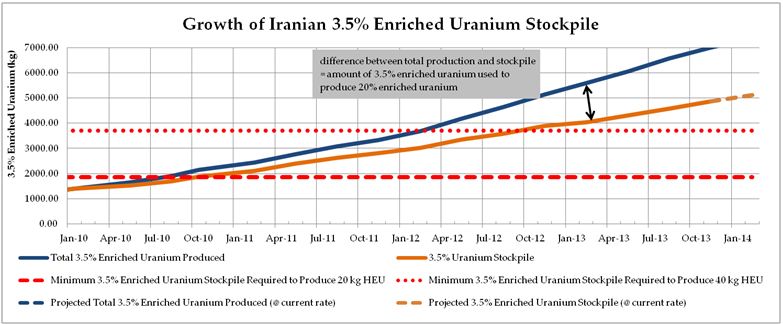


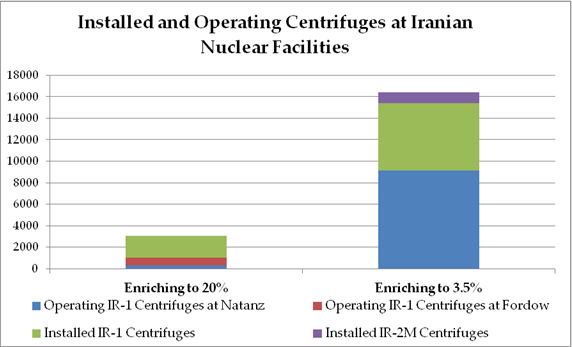

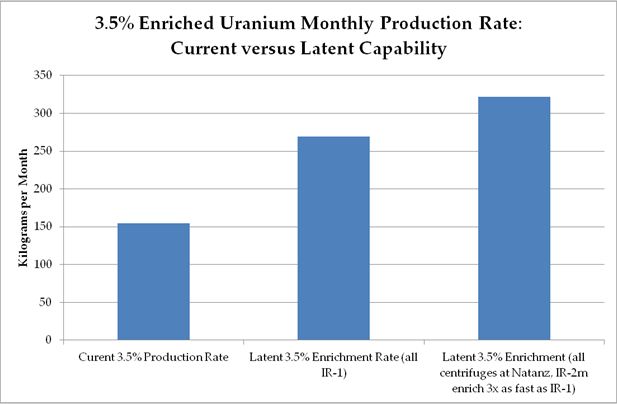
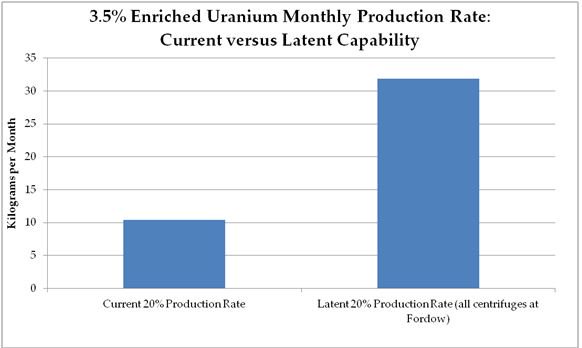
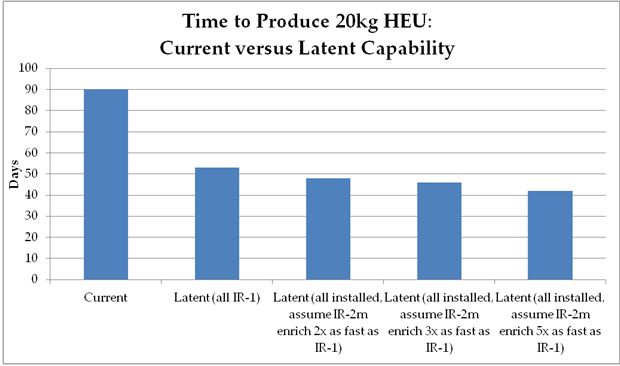



1 For enrichment, uranium must be in gas form as uranium hexafluoride (UF6). The IAEA reports its data in kilograms of UF6. However, for this paper, we will refer to solid form uranium. One kilogram of UF6 yields roughly 0.67kg uranium metal.
2 This range depends on whether Iran uses a two- or three-step batch recycling process to produce highly enriched uranium for a nuclear weapon and is based upon the work of Greg Jones at the Nonproliferation Policy Education Center. Both scenarios assume the use of the Natanz Fuel Enrichment Plant at its current production rate and drawing upon Iran’s current stockpiles of 3.5 percent and 20 precent enriched uranium. For a more detailed explanation, see here.
Share
Read Next
Support Research Like This
With your support, BPC can continue to fund important research like this by combining the best ideas from both parties to promote health, security, and opportunity for all Americans.
Give Now